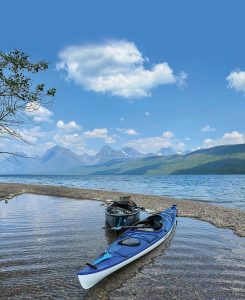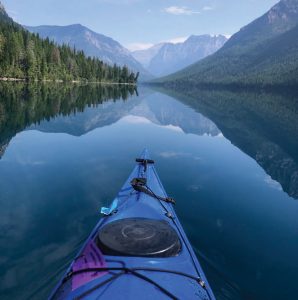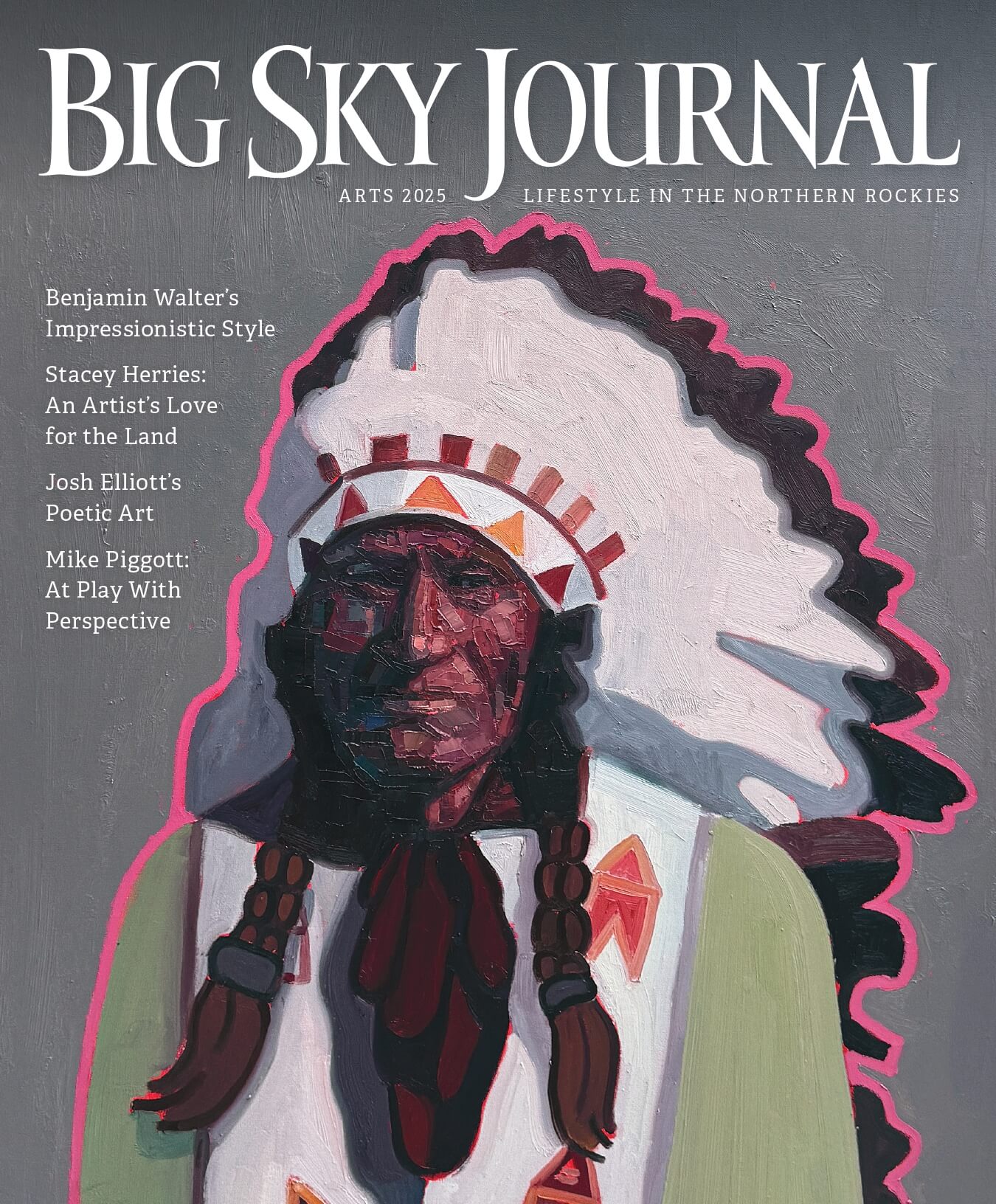
27 May Outside: Navigating Big Waters
Circling: following a lake’s perimeter and adhering closely to the shoreline while tracing the curve of bays and the tips of promontories. This way of kayaking a large body of water captivates me. Circling something truly marvelous and ending back where I started has answered a need in me.

Returning from a night of backcountry camping, Troy’s canoe and the author’s kayak bob in the shoals of Lake McDonald as their owners cool off in clear water.
9/7/2023 — Lake McDonald
I carried my Eddyline Samba to the beach and loaded the holds with food, water, and emergency gear. Even though this was supposed to be a day trip, I still packed my tent, sleeping bag, air mattress, and stove. A down jacket. A headlamp. I put on my Farmer Jane wetsuit, my PFD. I straddled my boat, lowered myself in, and then slid through the water.
Lake McDonald, the largest lake in Glacier National Park, is nearly 10 miles long, roughly 1 mile wide, and close to 500 feet deep. It is also simply gorgeous, rimmed by the Rockies. I wanted to see it from every perspective.
Eager to make time, I made for the first far point, cutting across the bay, but after that, I contoured the shoreline, both for safety and because there were more details to grab the senses. A sign in a fir tree read, “Stay away! Eagles nesting.” Old log cabins rested deep in the shadows. Green scents wafted growth and decay.
Six miles uplake, I stopped for a break at the gravel beach where my friend, Troy, and I swam in June. We’d camped there, too, at the backcountry campsite managed by the park. Aside from two deer that kept spooking us, we had the campsite to ourselves.
I felt a little smug, leaving the memory of us behind, heading off solo into an unexplored portion of the lake. An hour later, my arms were aching for a rest. The far shore was within reach. A man lounging in a reclining chair on the beach, magazine in his lap, watched my approach.
When I landed and explained where I’d come from, he kept repeating “Apgar?” quizzically, like he couldn’t believe it, like I’d said I just paddled in from Iceland. He stared into the blue haze. The man looked to be in his 40s, sandy-haired, with fine-boned hands and old-fashioned spectacles.
“Well, would you like a tour?” he asked, and I realized I was standing on private property.
The land belonged to his family, an old inholding with multiple cabins scattered around. He showed me the cabin his grandparents had built. It was a comfortable, lived-in museum of a home, with family photos gracing the walls. His family was large and scattered; various combinations of them stayed at the property a week at a time.
I declined his offer of lunch but let him take a photo of me just before I launched. I was headed toward Lake McDonald Lodge, where I would drink two non-alcoholic IPAs and eat a plate of greasy garlic fries. On my return, I struggled against a sundown wind and arrived at the dock with barely enough light to see. I had kayaked over 22 miles, the longest I’d ever done in a single day.
In October of 2023, just a month after I paddled around Lake McDonald, Troy died in a mysterious backcountry accident. He had planned a solo trip to several remote hot springs in central Idaho. He told me he wasn’t inviting anyone else because the ridge road to get there was dicey; steep slopes fell away on either side. I ran into him the morning before he left. He looked uncharacteristically anxious. “Make sure you text me your itinerary,” I’d said and hugged him tight.
Several days later, some hikers came upon him, drowned in a spring. His camp had been set up; his two dogs were with him. He wasn’t in central Idaho but in a pool much closer to home, just beyond the Montana–Idaho border. It wasn’t clear how he died, whether he slipped and hit his head or simply fainted. He was only 42 years old, a town mail carrier, and a gold-hearted guy, beloved by many.
Water is where I find my bliss. It’s where I go to heal. After that long, cold winter, I felt pulled toward the water, even before the season for kayaking began. I remembered my day of adventure, paddling around Lake McDonald, thoughts of Troy never too far away, and gradually fell into the idea of circumnavigating other wild lakes.
4/16/2024 — Lake Como
Even though it’s spring in Montana, I wear winter gear: a neoprene top over my wetsuit, my thickest gloves, my insulated hat. All of this is to stay warm while gliding over the newly melted-out surface, but also, hopefully, to prevent cold-water shock in case my kayak rolls over and I submerge.
Lake Como is home to me. In the summer, I swim there with my open-water swimming group. We aren’t organized enough to be a club, but we are more than a network of friends. We lap the beach, back and forth, in late June. By summer, we are stretching our swim to over a mile. By late August, we will be ready for our 3-mile swim to the falls, which I aim to kayak today.
Situated between Darby and Hamilton, Lake Como acts as a reservoir for the Bitterroot Valley. A dam and spillway contain its eastern flow. Three peaks loom over the far end of the lake. Officially, they are Como Peaks, but everyone I know calls them The Three Sisters. Rising up to the west and a bit in their shadow is The Lonesome Bachelor.
5/8/2024 — Alva and Holland Lakes
The next three lakes I visit are in the Seeley-Swan Valley, cradled between the Swan Mountains to the east and the Missions to the west. I pass by the first two lakes and pull into the parking lot for Lake Alva, with its thick larch forest. When I paddle out to the middle of the lake, I’m staggered by the sight of the snow-crested Swan Range rising up. I circle a tiny island. On the opposite shore, near an outlet stream, a beaver warns me off with the slap of its tail.
Later in the day, I drive to Holland Lake. I see “Save Holland Lake” signs hanging in the trees along the way. The signs are protesting plans to enlarge the footprint of Holland Lake Lodge. I first heard of these plans from friends in the Bitterroot who take their kids to Holland each year. When I carry my kayak to the beach, I discover why. The lake is a circle of clear, blue-green water, massed over by mountains. The blond, sugary sand of the beach feels imported from some luxury vacation spot. A “v” in the mountains indicates the falls, and I paddle toward them. Trout hang utterly still in the water until they sense the shadow of my kayak and flick away.

The morning waters of Bowman Lake are often completely stilled, doubling the mountains. Bowman Lake is located in the North Fork area of Glacier National Park, only 30 miles from the Canadian border.
7/16/2024 — Lindbergh Lake
I return to the Seeley–Swan Valley later in the season to kayak the perimeter of Lindbergh Lake. Charles Lindbergh flew over Lindbergh Lake — then called Elbow Lake — in his monoplane, The Spirit of St. Louis. Drawn to its rugged beauty, he took a break from his aeronautical tour of the country and spent several weeks in the area canoeing and camping. A boulder on the lake’s north end supposedly carries his inscription: Lindy 27.
I try to find the boulder but have no luck.
I do manage to kayak several hundred yards up the Swan River and then fly back down, a trip I repeat several times.
9/2/2024 — Bowman Lake
The trip to Bowman Lake, the last on my list, keeps getting deferred. But it may be that I keep inventing excuses. Bowman Lake is more remote, accessible only by rough gravel roads at the northern end of Glacier National Park. But in September, I overcome my worries about driving there alone and find myself on the beach at first light. Puffs of mist, waist high, race away from me across the lake’s surface.
A ranger walks up as I’m donning my wetsuit. He’s there to check my inspection tag. Kayaks, like other boats in Glacier, are inspected for zebra mussels and other invasive species. The ranger asks how far I’m going, and I say to the other side. He seems a little anxious about this.
“It’s beautiful over there, really beautiful,” he says after a moment.
Just my type of guy, right down to the warning he didn’t give. He gets back into his truck, and I shove off.
Bowman Lake looks and feels like glacial water — a long curving finger formed by ice melt, bound by mountains and moraine. I hear loons call deep into the morning. Is this an added benefit of the haze, the dimmer light? At the first gravel beach where I break, I eat trail mix while standing, facing the forest, alert for signs of bruin.
Another amazing consequence of the haze, and possibly the deposit of pollen, is that the water stays flat. I feel safe kayaking the middle path. Mountain reflections echo on either side of me. I’m splitting a mirage.
The mountains grow higher. I see twists in the trees marking hidden waterways, old avalanche shoots, and snowfields that might be small glaciers beading into streams.
And then I can go no further. I paddle toward a peninsula of pebbles broached by a rivulet. An eagle on its aerie flies away as I approach. Seven mergansers swim past me. I sit and eat, cutting parmesan and an apple with my knife. As I’m packing up, the splash of waves grows louder. The lake, so still for my arrival, has suddenly grown choppy. My watch reads 12:53. It’s amazing how the wind always intensifies around 1 p.m. in the mountains. The swells aren’t high enough to feel threatening, but I hug the shore just in case.
The sunset crowd by the beach is smaller here than that which awaited me at Lake McDonald. Together, we watch the highest peaks — one shaped like a bell, the other more or less like a great horned owl — turn russet, then rose. And then the other campers clear out, and it’s just he and I — the guy hidden in the fir trees who brought his guitar and is softly strumming.
Maria Kochis is a writer, avid outdoor enthusiast, and member of her county search-and-rescue team. Grateful to be living in the Bitterroot Valley of Montana, she worked as a librarian for many years and believes in the power of literature to change lives.




No Comments